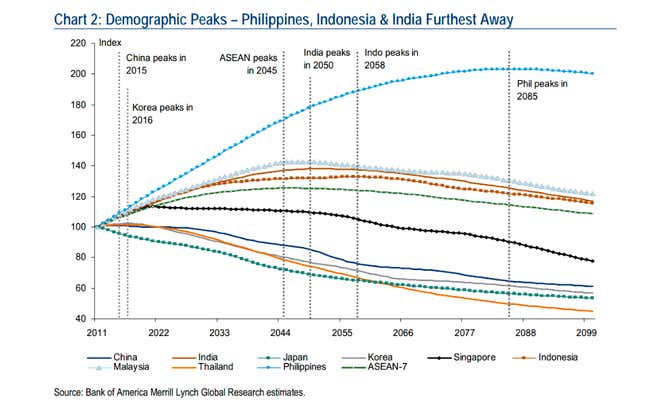The latest news on Thailand’s economy has been grim. Not only did the country enter a recession (paywall) in the second quarter of this year, but it increasingly faces the twin specters of rising household debt and capital outflows.
And now there’s news that makes the outlook even grayer—literally. As a new Bank of America/Merrill Lynch report puts it, Thailand is “emerging as the old man” of Southeast Asia. Due to a low fertility rate, its population is aging faster than previously assumed.
The dangerous implication for its economy is that Thailand’s working-age population will peak in 2017, rather than 2020, according to recent recalculations by the United Nations. So the labor force will start shrinking sooner than planned, falling 1.2% between now and 2023, according to BofA/ML projections.
More on why that’s bad in a moment, but first, here’s the chart. As you can see, by about 2060, Thailand’s working-age (the orange line) population shrinkage will have become the biggest in Asia:

This is important because, in real terms, adding workers to your economy is one of the two ways to grow. The other option—getting the same number of workers to produce more—is expensive and notoriously tricky to pull off. That’s why emerging markets with swelling labor forces grow fast, while rich-world countries with falling populations face the constant struggle of ramping up productivity.
Another problem: When a country runs out of new workers, demand for existing ones rises, driving up wages. That means companies have to either accept thinner profit margins, or pass the costs on to consumers and risk being less competitive with imports and services from abroad. Falling consumer spending resulting from aging (pdf) can also entrench deflation, and once prices start dropping, it can become a vicious cycle.
As you can see in the chart above, Japan, home to the world’s most calamitous graying, saw its working-age population peak way back in 1995. That has likely helped stymie GDP growth and perpetuate deflation.
But while Japan is the demographic anomaly in Asia, it won’t be for long. South Korea is rapidly following Japan’s lead; the ranks of its workers will start falling after 2016. And China’s working population will peak pretty much any day now.
With those countries to compare itself to, Thailand’s situation hardly looks dire. But the light is less flattering from a southern exposure. Thailand is the only Southeast Asian country whose workforce will shrink in the next decade, according to BofA/ML. Because the country is heavily dependent on exports—it makes a good chunk of the world’s cars, electronics and rice—it will have a hard time competing with countries like the Philippines (whose population won’t peak until 2085) and Indonesia (2058) for its share of regional trade.
